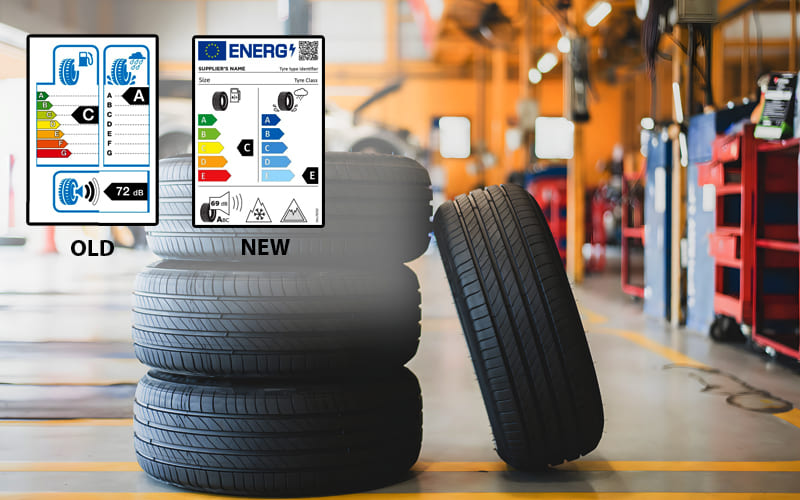Search Tyres by Vehicle Registration
Are you looking for Tyre Labelling for your vehicle?

The tyre label is a uniform European Union labelling on motor vehicle tyres, enabling the buyer to compare the different models better.
The 2021 tyre label - meaning, benefits and individual differences
The EU tyre label was already introduced in 2012 and shows a classification of motor vehicle tyres. This displays precise information on fuel efficiency, wet braking properties and noise level, which were divided into categories from A to G until 2021. Here, A was the best possible classification and G the worst. The tyre labelling was revised in May 2021.
In addition to the familiar information on wet grip, fuel efficiency and rolling noise in decibels, further helpful information has been added to the tyre label as of May 2021. The efficiency classes have also been revised.
The new standards apply, ensuring a uniform standard throughout the EU and UK. Instead of the previous three indications, there are now additional symbols on the new tyres.
To create as much comparability as possible, the following criteria are described in more detail on the EU label for tyres:
Rolling Resistance
This characteristic makes a statement about fuel savings. In this category, there were classifications from A to C and E to G until 2021. D was not used. The innovation: The efficiency classes F and G are now missing on the 2021 tyre label, and the previously unassigned class D is now used. Rolling resistance and fuel efficiency will thus be indicated in classes A - E from 2021 onwards to provide a quicker overview of tyre safety on wet roads.
If you compare a class A tyre with one from the last class E, you can achieve fuel savings of up to 9% by using a class A tyre.
Wet Braking Properties
This category describes the grip of the tyres on wet surfaces. This can directly impact safety and can account for differences of 30% in braking distance. Here, too, new efficiency classes have been introduced since 2021: Just as with rolling resistance, wet grip is divided into five classes - A to E.
If, for example, you take a class A tyre and compare it with a class E tyre, significant differences of several metres can occur. There is no information on a tyre's grip on dry roads on the new 2021 tyre label.
External Rolling Noise
To show the intensity of the external noise, the symbol of a tyre with three-quarter rings, or sound waves, was used until 2021. The fewer rings displayed, the quieter the Tyre's rolling noise. The external rolling noise information was also changed on the 2021 tyre label: For the noise development, there are three subdivisions from A-C on the new label so that the rolling noise of different tyres can also be compared with each other in the best possible way.
A winter tyre with the label class C1 can now be easily recognised on the new tyre print by two newly added pictograms, which is a clear step toward driving safety.
In addition to the described symbol, there is also the exact indication of the measured volume. Furthermore, the tyre limits are not the same for all tyres. They depend on the tyre width and the type of Tyre. If different tyres' wet grip and rolling resistance classifications match, the quieter Tyre should always be selected. However, low rolling noise cannot always be equated with low interior noise.
What do the symbols on the new EU tyre label mean?
The EU tyre label still provides information on fuel efficiency (rolling resistance), wet grip, and external rolling noise intensity. A new feature is a QR code on each Tyre, which can be used with a smartphone to read further information about the Tyre on the internet. The new EU tyre label contains information on the supplier and the dimensions, and the article number of the tyre manufacturer will also be noted on the tyre label from 2021. Winter tyres will also have the familiar snowflake symbol, and Nordic tyres will be marked with an ice symbol on the new tyre label.
What is behind the QR code on the tyre label introduced in 2021?
Anyone who scans the QR code on the tyre sticker before buying a new set of tyres will be taken directly to the EPREL database. This is a product database of the EU Commission that provides further information on the respective Tyre and contributes to increased transparency.
Conclusion
The EU tyre label is a good way to compare different tyres. It shows the most important characteristics of a new tyre in a clear and easy-to-understand way and has several advantages. With the help of the label, for example, you can save money on fuel, increase safety and reduce driving noise. Therefore, it is worthwhile to know the tyre label and the meaning of the individual symbols and compare the properties of the different tyres before buying.
We at PBT Supplies Ltd. hope you have found this information page helpful. If you have any additional questions about Tyre labelling Market Harborough, please get in touch.
